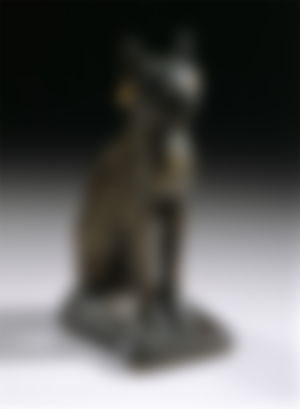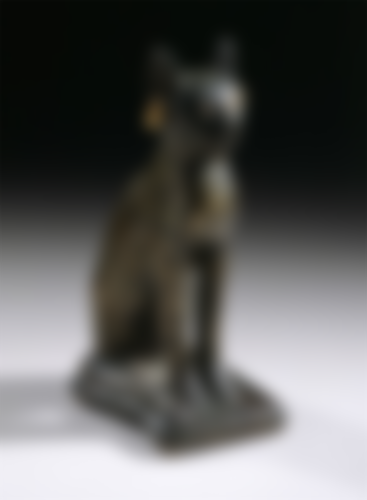Cats have existed in Egypt since pre-historic times; cat-like deities are known from oldest Pharaonic time, about 5000 years ago. It is possible, but unproved, that it was in Egypt the cats were first domesticated, if they are indeed domesticated. (For more about that, see "The Relationship Between Cats & Humans – Where did it Begin, and Why?")
Cat-like Deities in Ancient Egypt
Cat-like deities occurred early in Egypt. The oldest we know of is the lion-headed Mafdet, "The Great Cat", first known from a picture dated ca. 3100 BC. She was a goddess who protected against snakebites and scorpion stings. She also represented justice and executions. Mafdet is usually depicted as a woman with a lion's head, or the head of any other feline, and with tresses of snakes ending as scorpion tails. The Pyramid Texts (from about 2400 to 2300 BC) describes how she protects the sun god, Ra, against poisonous snakes.
Bastet (or Bast), the most famous Egyptian cat deity, was initially lion-headed. Also Wadjet, who is usually associated with a cobra, was sometimes pictured lion-headed. So even Sekhmet. Bastet is sometimes referred to as "The Lady of the East", where Sekhmet is the "Lady of the West".
The lion was important in Egyptian symbolism, a symbol of royalty and power. Very long ago, there were wild lions in Egypt. They disappeared quite early and were rare already in early dynastic time.
No cat deity is better known than the goddess Bastet (Bast), whose cult probably came to displace Mafdet's. Over time, Bastet became associated with a "domestic cat" rather than a lion. Her cult culminated when Shoshenq I (reigned 945-924 BC) developed the already then old city Bubastis to his and his dynasty's capital. Bubastis was an important centre in the cult of Bastet. The city lay east of the Nile Delta.
(The image shows Figurine of the Goddess Bastet as a Cat, 21st - 26th Dynasty (1081 - 525 B.C.. Sculpture. Bronze, inlaid gold. Original at Los Angeles County Museum of Art. The Image is in the Public Domain.)

According to Herodotus, cats were taken to Bubastis for mummification and burial.
One has found cat mummies in several different places. In Saqqara, south-west of Cairo, there were thousands – and in Beni Hasan there were so many that 19 tonnes of mummified cats already in the late 1800s were sent to England to be used for fertilisation of soil.
Bastet was initially a war goddess of Lower Egypt, later, the goddess of fire, cats, and homes, and she was particularly believed to protect against infectious diseases and evil spirits.
Cat worship was forbidden by law by the Roman Emperor in 390 AD.
Cats in Egypt Today - Islam
In today's Egypt, cats are not worshipped, but in most cases they are tolerated. According to Islam, the cat is not impure. It was narrated that the Prophet Muhammed had a favourite cat named Muezza, and that he at one point when she slept on the sleeve of the clothes he wanted to take when he went to prayer, cut off the sleeve so that he could take the clothes without interrupting the cat's sleep. Then he stroked the cat three times, which, according to the story, gave the cat seven lives and the ability always to land on its feet.
It is also narrated that the Prophet had been drinking water from the same pot as the cat and that he could perform his ablutions before prayer in the same water the cat was or had been drinking from. It is an extreme testimony of how he saw the cat's purity, even ritually.
According to Islam, a cat must be loved and treated well. To harm a cat is considered a grave sin.
Islam states that a cat can not be sold for money or goods; the cat's saliva is harmless as far as one cannot see the impurities in the mouth; and that one may live with a cat, provided one treats it well.
Unfortunately, today's Egyptians don't always treat cats well, although Islam is deeply rooted in the Egyptian mind, even if it is not always immediately visible. But that has not stopped Egyptian authorities from fighting stray cats as vermin.

Egyptian Mau - EMRO
Egyptian Mau is a cat breed that, according to one story, was "created" in 1952 in Italy, when a Russian exile princess saw the cat of the Egyptian ambassador and persuaded him to give her a number of cats from Egypt, with which she began breeding.
DNA analysis suggests that the breed probably originated mainly in Europe and North America, but it certainly has to do with Egypt, in the sense that the cats came from the area around Cairo before they were brought to Italy. It is also common belief that the breed descends from ancient, sacred Egyptian cats. I dare not say what is truth and myth here, even genetic analyses can be difficult to interpret. But it is the only naturally spotted cat breed, and it has the typical scarab marked forehead. It looks like an "M".
In ancient Egypt, the cat was a sacred animal, and there are many cat mummies. Whether those mummies have a genetic kinship with today's Egyptian stray cats, which are available in huge numbers, I do not know - but it is probable, and it would be an interesting topic for a research project to find out whether or not that is the case.
A private organization, EMRO (Egyptian Mau Rescue Organization) tries to save what they perceive as Mau cats in Egypt, channeling some of them to the breeding of the formally approved cat breed, Egyptian Mau.
EMRO also organises care for sick cats and looks for cat lovers worldwide who can adopt a cat. On the whole, a valuable voluntary work. You can read more on EMROs website. http://www.emaurescue.org/
The name "Mau" is derived from the Middle Egyptian word "mw" which means "cat". (Middle Egyptian is the language that was used in Egypt around 2000-1300 BC.)
Copyright © 2020 Meleonymica/Mictorrani. All Rights Reserved.
All my articles about Egypt and Egyptology can be found here.
Interested in history, legends and myths, join my community History, Myths, Legends & Mysteries (be45).
You find all my writings on Read.Cash, sorted by topic, here.

